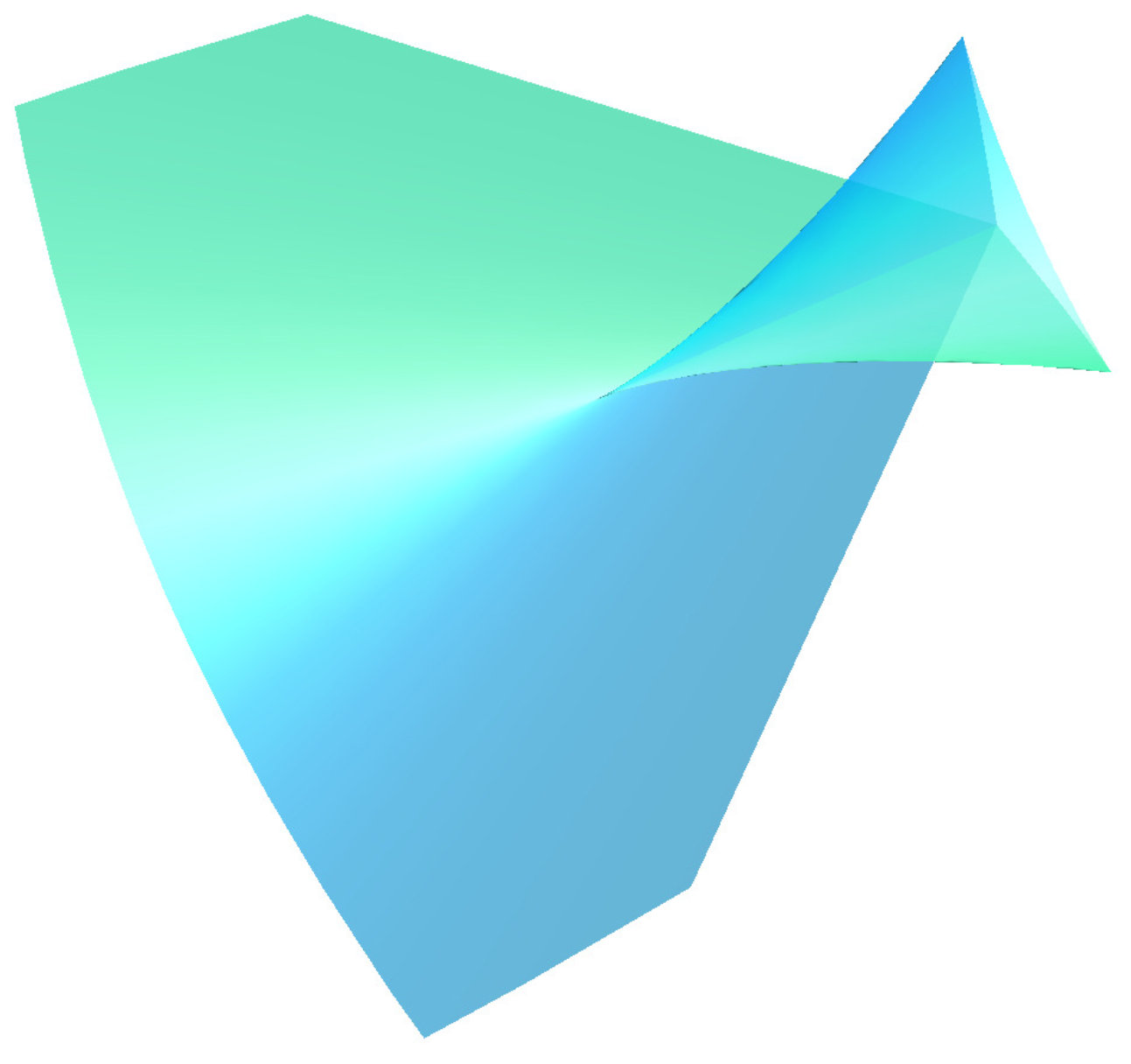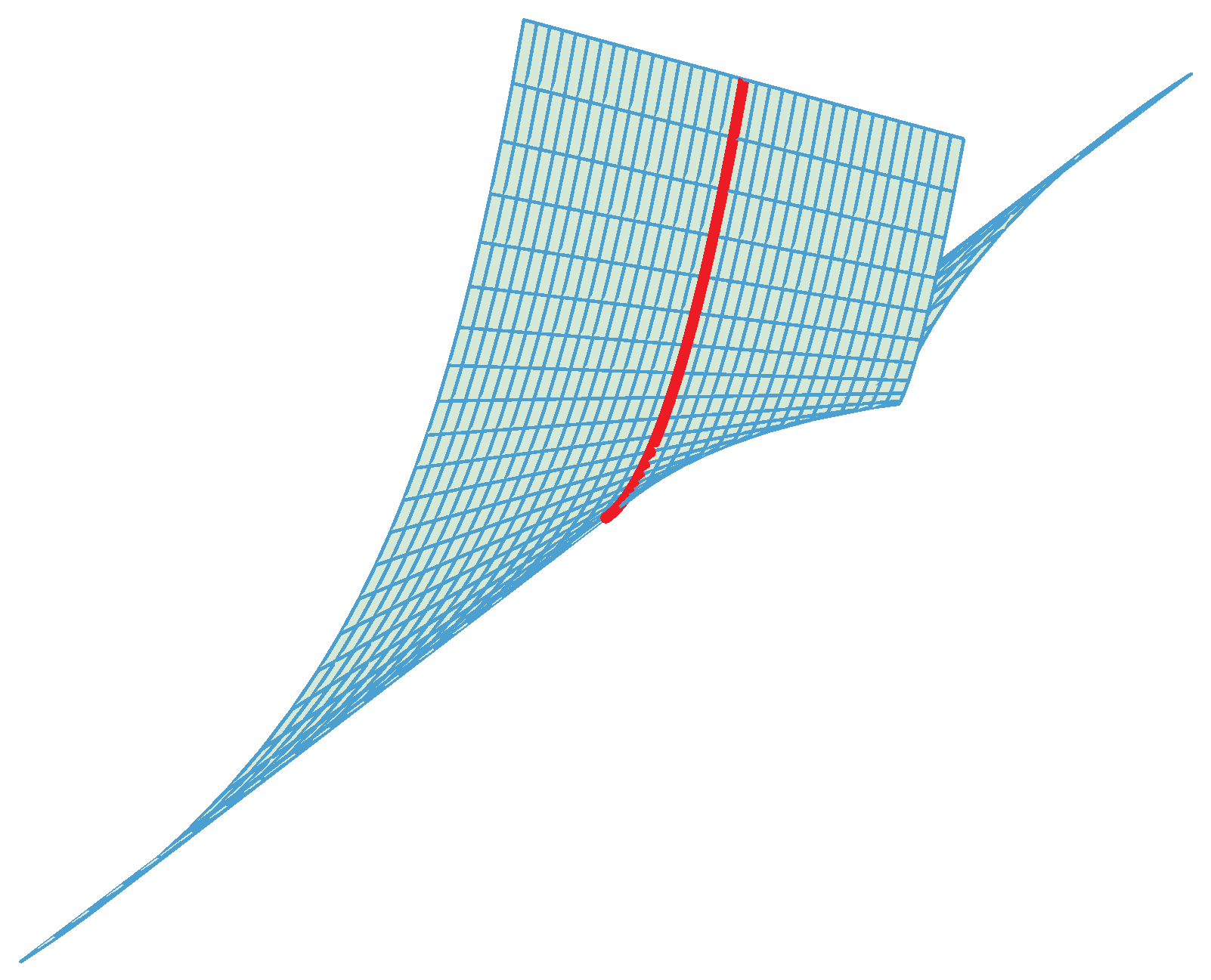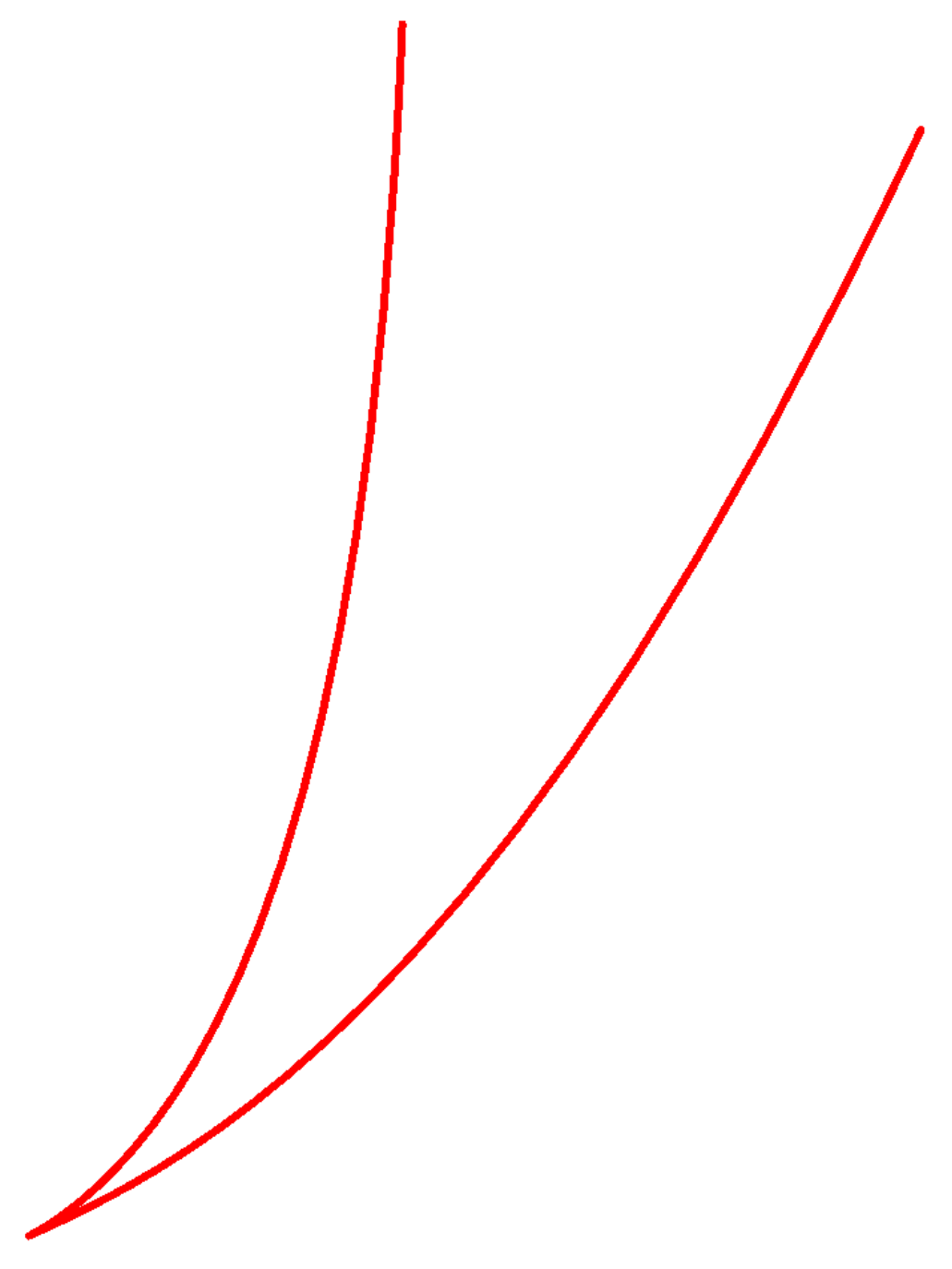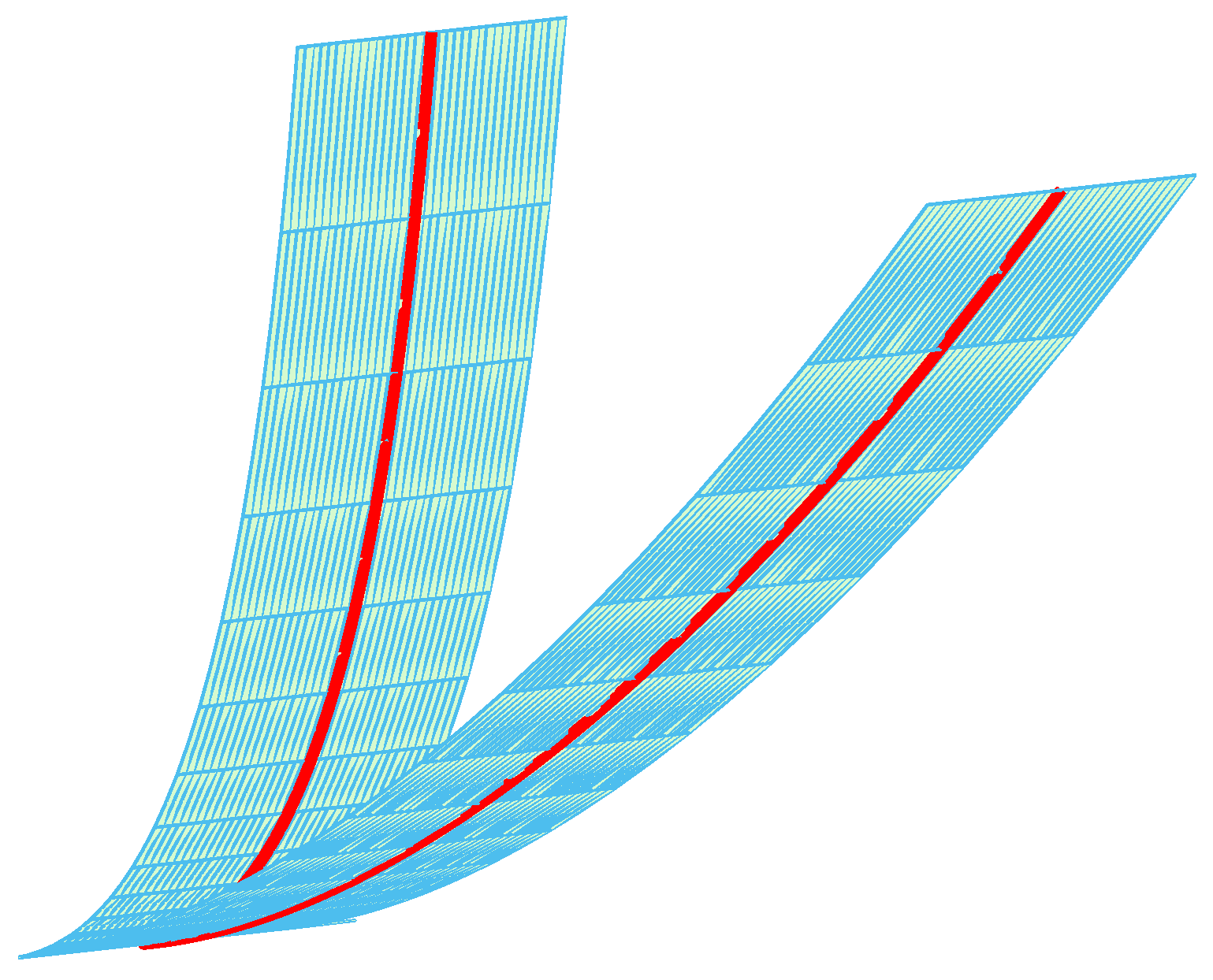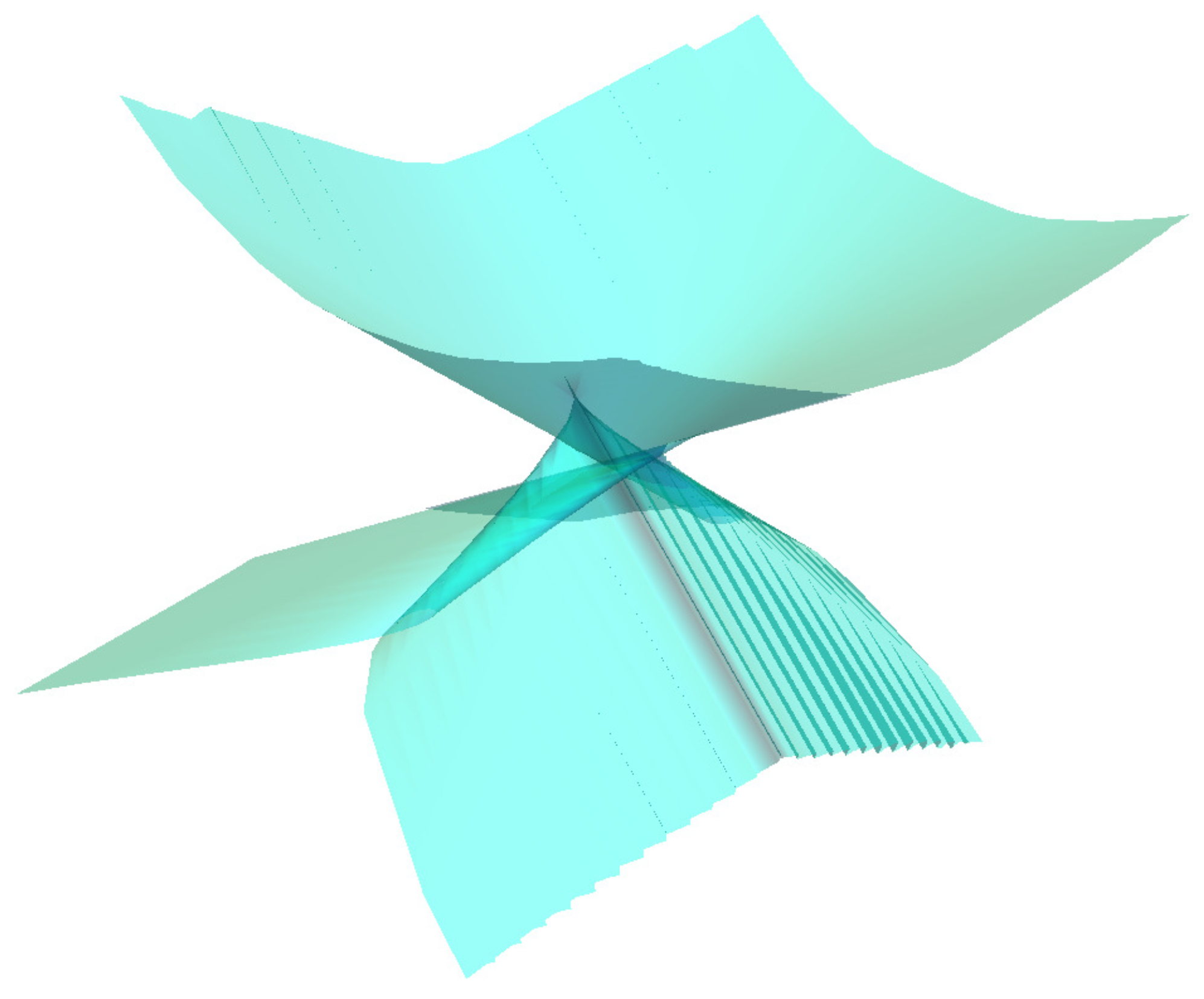1. Introduction
The pseudo-Riemannian space has a vital position in the research of differential geometry and physics, among which the Minkowski space is an important space model in relativity [
1]. Curves and their related submanifolds are attractive research subjects in differential geometry and physics [
2,
3,
4,
5,
6] particularly for geometric objects that have interesting optical backgrounds and meanings. For example, F. Ateş et al. studied special curves formed by reflected light rays in different spaces and analyzed the singular properties of related submanifolds [
7,
8]. Moreover, the nullcone front in this paper can be regarded as a surface formed by the trajectory of light rays emitted from each point on a spacelike curve. This is a special relativity understanding of Fermat’s principle that regards the light as particles [
9].
If a spacelike curve is regular, we can use the Frenet frame to obtain most of the information of the curve, and then we can characterize properties of the curve and its related submanifolds [
10]. However, as we know, for singular curves, the Frenet frame does not exist at the singularities, such as cusps, inflection points, etc., which makes it impossible to utilize the Frenet frame to study the curve and its related submanifolds near the singularities.
For this reason, some authors constructed or adopted different tools to study the objects in different spaces [
11,
12,
13]. Particularly, S. Honda and M. Takahashi defined framed curves in Euclidean space. Then, they used framed curves to character the singular curve in Euclidean 3-space. This is not only the promotion of Frenet curves but also the promotion of Legendre curves [
14]. Subsequently, using the framed curve as a tool, some authors have studied geometric objects in different spaces [
15,
16,
17].
The spacelike curve is a classical geometric object of semi-Euclidean space. For instance, S. Izumiya, the second author and T. Sano studied regular spacelike curves in Minkowski 3-space [
18]. However, spacelike curves may contain singularities. To solve this kind of problem, in present paper, we extend the notion of framed curve to the Minkowski 3-space. We show the definition of spacelike framed curves in Minkowski 3-space. Then, the nullcone fronts of a spacelike framed curve are defined. Then, the singularities of them are classified as a generalization of the conclusions of S. Izumiya et al [
18].
The brief structure of the present paper is as follows. In the next section, we introduce the fundamental definitions in Minkowski 3-space. We show the definition of spacelike framed curves. Then, Frenet type formulae of a spacelike framed curve are given. In
Section 3, we show the definitions of nullcone fronts and give the main classification theorem of this paper (Theorem 3). In
Section 4, we review the criteria for singularities of fronts. We show the proof of Theorem 3. Finally, we show several (singular) curves as examples in
Section 5, whose nullcone fronts may have cuspidal edges or swallowtails.
2. Preliminaries
Let
be the 3-dimensional real vector space. The pseudo scalar product of
and
is defined by
for any vectors
in
. Then, the space
is called the pseudo-Riemannian 3-space with index 1 or the
Minkowski 3-space.
If a non-zero vector satisfies , or , then the non-zero vector is called a spacelike, timelike or null vector respectively. Let be a regular curve, that is, for any . We say that a curve is a spacelike, timelike or null curve if its tangent vector is spacelike, timelike or null for any . The category to which a given vector or curve belongs is called its causal character.
Three kinds of pseudo-spheres in are defined as follows.
The
pseudo 2-sphere is defined by
the
hyperbolic 2-space is defined by
and the
nullcone with the vertex is defined by
Moreover, for any vectors
and
in
with components as above, the pseudo vector product of them is given by
where
is the canonical basis of
.
On the other hand, a spacelike framed curve in Minkowski space is a spacelike curve with a set of moving frame fields along the curve.
Let
be a spacelike curve. Then, the map
is called a
spacelike framed curve if
where
or
At this point, the curve is called the original curve of the spacelike framed curve. Then, we define , which is a spacelike vector field. Moreover, we can find a smooth function that satisfies . It is easy to perceive that the original curve is singular at the point if and only if .
Remark 1. In accordance with the causal character of the component of the frame field, we know that there are three kinds of frame fields for a spacelike curve [
19].
In consideration of the objects we studied in the present paper, only two are given here. We denote
, and then the Frenet type formulae for a spacelike framed curve are given as follows.
where
,
,
. We call functions
the
curvature of the spacelike framed curve.
The existence and uniqueness theorems for spacelike framed curves are shown as follows.
Theorem 1 (The Existence Theorem). Let be a smooth map. There exists a spacelike framed curve whose curvature of the spacelike framed curve is .
Proof. Let
be any functions with the properties that
,
,
for all
. Moreover, let
be the vector fields in
and
. We define smooth functions
,
,
that satisfy
,
, and
. Then,
is defined by
, that is,
It follows that , , and for all . Therefore, there exists a spacelike framed curve whose curvature of the spacelike framed curve is . Similarly, we can obtain the existence theorem for the case of and . □
Definition 1. Let and be spacelike framed curves. We say that and are congruent as spacelike framed curves through a Lorentzian motion if there exist a matrix and a constant vector such thatfor all , where the matrix satisfies Proposition 1. For any vectors and , we have The fundamental theorem of non-lightlike curves has been given in [
20,
21]. Referring to them and Proposition 1, we show the following theorem.
Theorem 2 (The Uniqueness Theorem). Let and be spacelike framed curves whose curvatures and coincide. Then, and are congruent as spacelike framed curves through a Lorentzian motion.
For a regular spacelike curve with linear independent condition, that is, and are linear independent for all . By direct calculations, we have the following proposition.
Proposition 2. Let be a spacelike framed curve with the curvature of the spacelike framed curve . Then, the relationships between the and the curvature and torsion of are given by 3. Nullcone Fronts of a Spacelike Framed Curve
In this section, nullcone fronts of a spacelike framed curve are defined. Then, we give the classification theorem of their singularities as main theorem of the present paper.
Definition 2. For a spacelike framed curve , we sayis the nullcone front of . Remark 2. be defined in the same way as above, which is also called the nullcone front of a spacelike framed curve.
Remark 3. We can verify that are null vectors. Therefore, the nullcone fronts we defined above can be regarded as the surfaces formed by the trajectories of light rays emitted from each point on a spacelike curve . This is a special relativity understanding of Fermat’s principle that regards the light as particles. More detailed physical explanations can be found in [
9].
The following theorem shows the singularity classification of the nullcone fronts we defined above.
Theorem 3. Let be a spacelike framed curve with , and then we have the following.
- (1)
The nullcone fronts of the curve are regular except the point , where .
- (2)
The nullcone fronts of the curve are diffeomorphic to the cuspidal edge at if and only if and .
- (3)
The nullcone fronts of the curve are diffeomorphic to the swallowtail at if and only if , and .
Here, is the cuspidal edge (
Figure 1),
and is the swallowtail (
Figure 2).
Remark 4. The regular spacelike curves and their nullcone fronts in Minkowski 3-space are discussed in the previous work of S. Izumiya, the second author and T. Sano [
18].
In the present paper, the spacelike curve that we studied may contain singularities. Therefore, Theorem 3 is an extension of the conclusions (Theorem B) in [
18].
For the sake of proving Theorem 3, we must make preparations in
Section 4. Then, we will show the proof of Theorem 3 at the end of
Section 4.
4. Criteria for Singularities
We review the criteria for singularities of fronts and related definitions briefly in this section. The word ‘front’ comes from physical fronts. Here, we use mathematical language to describe it. It is a generalization of the definition of a surface. More details can be found in [
22,
23]. In addition, we show the proof of Theorem 3 at the end of this section.
We say a smooth map
is a
front if there exists a vector field
along
f such that
is a Legendrian immersion. Then, there exists a smooth function
on
U, which is called the
signed area density function, such that
If a singular point satisfies , then is said to be non-degenerate. By parameterizing the set of singular points of f, we obtain the singular curve, which satisfies . Then, we choose a null vector field along such that for each t.
Based on the definitions above, we show the following criteria for singularities. This not only simplifies the traditional proof process but also has a wider range of application.
Theorem 4 ([
22,
23])
. Let be a front and be a non-degenerate singular point of f. Meanwhile, is the singular curve satisfies , and is the corresponding null vector field. Then, we have the following.- (1)
The germ of f at is locally diffeomorphic to a cuspidal edge if and only if the null direction is transversal to .
- (2)
The germ of f at is locally diffeomorphic to a swallowtail if and only if the null direction is proportional to and
Proof of Theorem 3 . According to Definition 2 and formulae (
1), we obtain
Thus,
is a singular point of
if and only if
This assertion means that conclusion (1) in Theorem 3 holds.
Through the calculations above, we derive that are fronts. Moreover, it can be verified that is a non-degenerate singular point of since .
We take the singular curve as
and the null vector field as
Then, we obtain
where
. Then, by using the criteria for singularities (Theorem 4), conclusions (2) and (3) in Theorem 3 can be obtained. □
Remark 5. According to the Equation (2) in the proof above, we know that if , then the trajectory of the set of singularities of nullcone fronts is a trivial regular curve.

